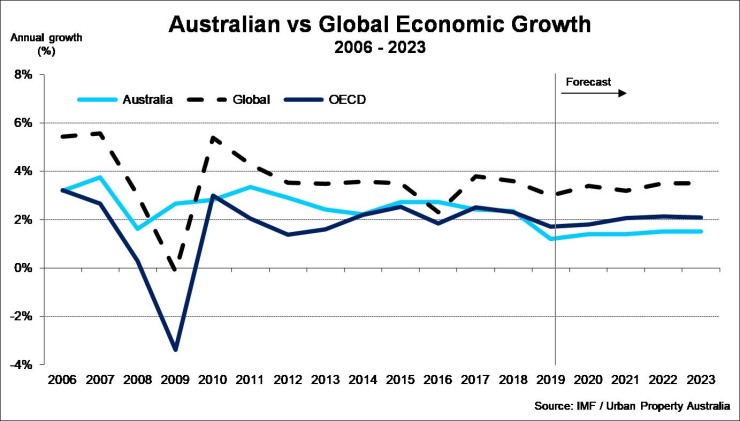Q3 2019 – Global Economic Overview
October 22nd 2019 | , Urban Property Australia
- Trade tensions between the United States and China continue to adversely impact business sentiment and confidence globally;
- While the Australian economy has slowed, there had been a pick-up in quarterly GDP growth over the first half of 2019 driven by stronger growth in exports;
- Victoria’s nation-leading population growth continues to support the state economy and strong employment gains.
Economic Summary
Global economic growth continues to slow, impacted by heightened policy uncertainty that has affected international trade and business investment. Similar to global conditions, the Australian economy has also moderated, however the stabilisation of the housing markets and a brighter outlook for the resources sector should all support growth domestically in the short term.
Global Economic Overview
The pace of global economic activity remains weak, with global growth of 3.0% forecast in 2019, its lowest rate since 2009. Trade tensions, which had abated earlier in the year, have risen again sharply, resulting in significant tariff increases between the United States and China and hurting business sentiment and confidence globally. Looking ahead, the world economy is projected to improve modestly in 2020, growing by 3.4% boosted by emerging economies which have underperformed in recent years. Beyond 2020, global growth is forecast to increase by 3.6% as the global economy shifts towards emerging and developing economies such as Brazil, Mexico and Argentina.

United States
While trade-related uncertainty has had negative effects on investment, employment and consumption continue to be robust, buoyed also by policy stimulus. Growth in 2019 is expected to be 2.4%, moderating to 2.1% in 2020. The projected moderation reflects a more neutral fiscal stance as stimulus from the recently adopted two-year budget fades. House prices are still rising, but their growth is now at the slowest rate in seven years. That weakening of the momentum in US housing prices comes as the economy slows and as demand for new and existing homes remains relatively weak. On the other hand, consumer confidence continues to rise reflecting the employment and wage growth.
China
In China, a range of indicators suggested that the pace of economic activity had slowed since the start of the year. Economic indicators remained subdued in August, although they had recovered a little from broad-based weakness in July. With policy stimulus expected to continue supporting activity in the face of the adverse external shock, growth is forecast at 6.1% in 2019 and 5.8% in 2020.
Europe
In the euro area, weaker growth in foreign demand and a drawdown of inventories (reflecting weak industrial production) have kept a lid on growth since mid-2018. Activity is expected to pick up only modestly over the remainder of this year, and into 2020, as external demand is projected to regain some momentum and temporary factors (including new emission standards that hit German car production) continue to fade. Growth is projected at 1.2% in 2019 and 1.4% in 2020. Economic growth in both France and Germany have been revised down due to weaker-than-expected external demand in the first half of the year.
United Kingdom
The United Kingdom is set to expand at 1.2% in 2019 and 1.4% in 2020, weighed down by the negative impact from weaker global growth and ongoing Brexit uncertainty. The economy contracted in the second quarter, and recent indicators point to weak growth in the third quarter. The forecast assumes an orderly exit from the European Union followed by a gradual transition to the new regime. However, as of early September, the ultimate form of Brexit remains highly uncertain.
India
India’s economy is set to grow at 6.1% in 2019, picking up to 7% in 2020. India’s economic growth has been revised down, impacted by the weaker-than-expected outlook for domestic demand. Growth will be supported by the lagged effects of monetary policy easing, a reduction in corporate income tax rates, recent measures to address corporate and environmental regulatory uncertainty, and government programs to support rural consumption.
Copyright © 2019 by Urban Property Australia All rights reserved. No part of this publication may be reproduced in any form, by microfilm, xerography, electronically or otherwise, or incorporated into any information retrieval system, without the written permission of the copyright owner.



